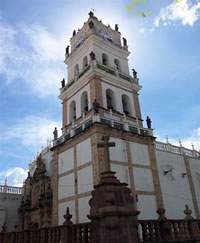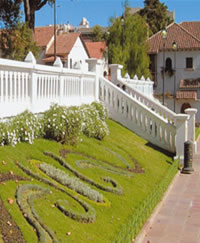- Why to Study Spanish in Sucre?
- Sights of Sucre
- History
- Climate & Weather forecast
- How to get to Sucre?
- Sucre’s Nightlife


Sights of Sucre
Plaza 25 de Mayo
Plaza 25 de Mayo is the central place and meeting point. It is a large and spacious, full of beautiful trees and palms surrounded by elegant buildings. Go there and enjoy the beautiful environment and it lively atmosphere.

The House of Freedom (La Casa de la Libertad)
Built in 1621, it is perhaps the most important building of the nation. The republic was founded in this building by Simon Bolivar who wrote the Bolivian Constitution.
The “Salón de la Independencia” houses the Bolivian Declaration of Independence. The house of freedom contains a very famous portrait of Simon Bolivar by the Peruvian Artist Gil de Castro, admired for it’s likeness. You should visit this historical place alone or with your Spanish teacher!.

Universidad Mayor de San Francisco Xavier:
Founded on March 27th, 1624 by Padre Juan de Frías Herrán.

National Library (La Biblioteca Nacional)
Built on the same year of the foundation of the Republic, it is the first and the most important historical, bibliographical and documentation center of the country. The National Library has documents that date from 15th century.
Metropolitan Cathedral (La Catedral Metropolitana)
 Built between 1559 to 1712, the cathedral has the “Museo Catedraliceo” which is the first and most important religious museum of the country. The “Pinacoteca” has a vast collection of paintings by Colonial and Republican masters and also by Europeans such as Bitti, Fourchaudt and Van Dyck. The Cathedral contains a vast amount of jewelry made of gold, silver and gemstones. Especially you should see the famous jewel-encrusted Virgin of Guadalupe, 1601, and works by Viti, the first great painter of the New World, who studied under Raphael.
Built between 1559 to 1712, the cathedral has the “Museo Catedraliceo” which is the first and most important religious museum of the country. The “Pinacoteca” has a vast collection of paintings by Colonial and Republican masters and also by Europeans such as Bitti, Fourchaudt and Van Dyck. The Cathedral contains a vast amount of jewelry made of gold, silver and gemstones. Especially you should see the famous jewel-encrusted Virgin of Guadalupe, 1601, and works by Viti, the first great painter of the New World, who studied under Raphael.
Archbishop's Palace (El Palacio Arzobispal)
Built in 1609, was an important religious and historic institution during colonial times.
Churches and Convents
San Felipe Nery in Calle Azurduy y Ortiz with a free guide from universidad de Turismo office on Plaza 25 de Mayo. The neoclassical church is closed but ask the guide nicely to gain access. The roof which offers fine views over the city, is only opened for an hour between 16:30 and 18:00 (times changes in Bolivia J) The monastery is used as a school.

San Francisco (1581) in Calle Ravelo, has altars coated in gold leaf and 17th century ceilings; the bell is the one that summoned the people of Sucre to struggle for Independence.

San Lazaro (1538) in Calle Calvo/Padilla is regarded of the first catedral of Sucre. On the nave walls are six paintings attributed to Zurbaran; it has fine silverwork and alabaster in the Baptistery.
Santa Mónica in Calle Arenales/Junin is perhabs one of the finest gems of Spanish Architecture in the Ameracas, but has been converted into a multipurpose space.
Santa Barbara
San Miguel completed in 1628, has been restored and it very beautiful with Moorish-style carved and painted ceilings, alfaries (early 17th century), pure white walls and silver altar. In the sacristy some early sculptures can be seen. Entry is not allowed if you are wearing shorts or short skirts.
La Recoleta, at the top of Dalence, here you have a great view over the city. In addition there is a beautiful Franciscan convent. It is notable for the beauty of its cloisters and gardens; the carved wooden choir stalls above the nave of the church are especially fine. In the grounds is the Cedro Milenario, a 1400 year old impressive cedar tree.

Museums in Sucre
Museo Textil Etnografico San Alberto 413, between San Lazaro and Plaza 25 de Mayo, this excellent museum displays of regional textiles and traditional techniques, shop sells crafts. It is run by Antropologicas del Surandino. www.bolivianet.com/asur
Museo Santa Barbara Calvo 212, displays paintings, books, vestments, some silver and musical instruments, there is a window with a beautiful view to the church. Small items made by nuns are for sale.
Museo Universitario Charcas Bolivar 698, has anthropological, archaeological and folkloric exhibits, and a colonial and a modern art gallery.
Tarabuco (to 65 kilometres of Sucre)
Tarabucohas Sundays one of the most coloring markets of South America. From very early, craftsmen and weavers give themselves appointment in the principal square, and begin to arm the positions in those that they will exhibit throughout the day, the articles that they create with their own hands.
Some weavers show as, like they spin the wool in the looms of cane, whereas a group of natives exhibits one of the most representative local dances, Pujllay (play),accompanied of such autochthonous instruments as the quena, and the small guitar.
Tarabuco is the people of the Andes that better has preserved their gowns and their customs. You will be surprised with the strange suits that the settlers dress and with the denials of some elders (clothes, like the former ones of the empire incaico) that refuse to be come out in photographs for that they believe that the camera "will steal the soul from them ".
If you still want to practise former customs as the “trueque" (Exchange), to know the gown, music, typical dance, and great color of theirs textiles. You should take this tour!!!

The Dinosaur Park
At this extensive area of dinosaur footprints, found in the cemesa cement works, tracks from three types of dinosaur have been identified. Ask your school for further information.

Phone: (591)-4-6436727 Mobile: (591)-73981878 Calvo No 350 (Street from the main square up)
Sucre - Bolivia

